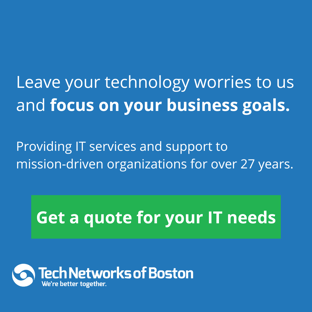When you set out to work at, or run, a nonprofit you probably didn’t think you would need to think about IT at all, let alone manage or budget for it. While you don’t need to be an IT expert to successfully run your organization, you and other stakeholders need to have a basic understanding of the technology that you use and a plan for how to leverage it for success. Are you stressed out about the current state of your technology, tired of using a break-fix approach, or at a loss about budgeting for tech? We’ve compiled a list of the basic knowledge you need surrounding IT to help your nonprofit succeed.
When to invest in technology
One of the hardest things about technology budgeting, especially at a small organization, is determining which hardware and software options are worth the investment and which you can skimp on. Because of this, it is common for nonprofits to purchase used technology which, while affordable, is unreliable at best and dangerous at worst. Instead you should make sure your team is running new, or at least new-ish, machines that can handle regular day-to-day operations and some wear and tear.
What training options are available for your staff
Since it’s likely your organization doesn’t have a robust IT staff, all your staff needs to be trained on proper security and file management. Your employees are your first line of defense against cyber-attacks, because they are often the targets. By setting up trainings, creating systems and processes, and performing phishing tests you help train your staff in best practices.
Where it is possible to save money
While we don’t recommend cutting costs for cutting costs sake, there are places where you can save money and still get a lot of value. Migrating to the cloud, using free or cheap design software like Canva, applying for the Google Ad Grant for Nonprofits, and other options all allow you to operate well with a small tech budget.
What innovations are happening in tech – and how you can use them
Reading the latest tech blogs probably isn't a priority for you (and it doesn’t have to be) but it is a good idea to stay in the loop about innovations in tech that can help your organization meet it’s goals. New technology can help you with data management, efficiency, and communication in ways that can transform the way you work.
Who can properly manage each part of your IT infrastructure?
There are lots of roles and functions that fall under the umbrella of IT, but that doesn’t mean that they all require the same skills. While you might not have the budget, or need, to employ full-time helpdesk staff, IT Directors, or even a CIO, it is important that you have team members overseeing those functions that are equipped to handle both day-to-day and big picture needs.
While this doesn’t cover all the variables surrounding IT needs at a nonprofit, it does give you a good jumping off point to help you understand, and manage, your nonprofit’s IT. One of the most important things you can do as a nonprofit leader is talk to others in the sector, find out what they’re doing and how they think about things, and use that as a touchpoint for your decisions.









Leave a Reply